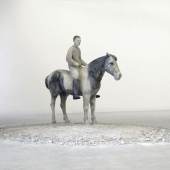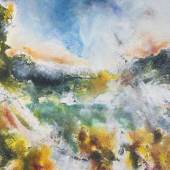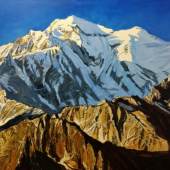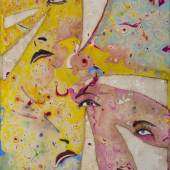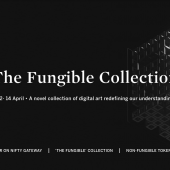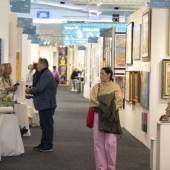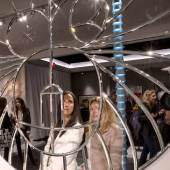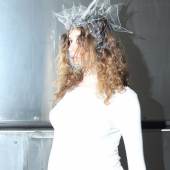Amanita
A healthy dose of poison Adrian Schachter
-
Ausstellung05.08.2024 - 01.09.2024Amanita »
Then happened that which made me lighter: for the dwarf sprang from my shoulder, the prying sprite! And it squatted on a stone in front of me. There was however a gateway just where we halted. «Look at this gateway! Dwarf!» I continued, «it hath two faces. Two roads come together here: these hath no one yet gone to the end of.
This long lane backwards: it continueth for an eternity. And that long lane forward—that is another eternity. They are antithetical to one another, these roads; they directly abut on one another:—and it is here, at this gateway, that they come together. The name of the gateway is inscribed above: ‘This Moment.’ But should one follow them further—and ever further and further on, thinkest thou, dwarf, that these roads would be eternally antithetical?»— «Everything straight lieth,» murmured the dwarf, contemptuously. «All truth is crooked; time itself is a circle.»
— Thus Spoke Zarathustra, Friedrich Nietzsche
Contemporary mithridatism
«To represent terrible and questionable things is in itself an instinct for power and magnificence in an artist: he does not fear them. There is no such thing as pessimistic art. Art affirms.»
Friedrich Nietzsche, Fragment 821, March-June 1888.
How many truths exist? At first glance, the works of Adrian Schachter confirm at least one. If entropy measures the closeness of a system to a state of equilibrium, the Engadin landscape achieves a state of grace. Nature has always tempered and inspired mankind. Even philosophers such as Giacomo Leopardi and Friedrich Nietzsche were psychophysically sensitive to the weather, and thus constantly in search of a balance between inside and outside. A coveted, triadic harmony between climate, body and spirit.
Nature is therefore a source of healing. But also of death. Another truth? Schachter makes it his own. He discovers the benefits and rigidities of Alpine nature. He walks, climbs and learns how resting is equivalent to an act of resistance. The creative otium of the ancients. Here he reads Thus Spoke Zarathustra – ideated in this valley – the alchemical IO Magazine1 and the oeuvre of Paracelsus, whom he pays homage with the title of this exhibition. The Swiss naturalist physician and philosopher wrote: «nature is the doctor, not you. From her you must take orders, not from yourself. Just try to learn where her medicines are, where her virtues are written down and in which treasure chests they are stored.»
If, then, «it is the dose that makes the poison,»3 it will suffice to extract the essence from the matter, or the pure from the impure, to bestow the curative virtue – and the creative one, in the case of the artist. Here comes back the ancient motto solve et coagula (dissolve and combine), dear to the alchemists. Adrian Schachter translates this other truth into his paintings: he unites, mixes, blends different elements together, balances their doses, depotentiates their “toxicity”, and then he concretises and fixes them on canvas. The result are works that, in their postmodern genesis, are not afraid to emanate an often irreverent glance at the human being.
Schachter does not merely celebrate a contemporary panismo, a nature-worship, with his canvases. While gravitating around the Engadine paths and strolling along the streets of the small villages he has known since childhood, the artist contemplates his fellow human beings. How do they act in this temple of purity nestled between lakes and icy peaks? Schachter is a carefree observer. He retains the amused gaze of a child, also capturing with witty irony the dichotomies, excesses and desires of those who sometimes come here more to flaunt than to participate quietly in the miracle of nature. It is that Nietzschean Ironischen Widerstande. An “ironic resistance” to the whims of customs and the ego; a counterbalance, to use Baudrillard’s words, to the «process of sacralisation of the body [...] taken up in its materiality as an object of narcissistic cult or tactical element or social ritual [in which] the two major leitmotifs are beauty and eroticism.»4
But Adrian Schachter’s eye also focuses on the concealed, the mystical, the nebulous. Truths overshadowed by the patina of time, steeped in widespread Engadin folklore. These are also evident in the sculptural decorations around the gates of the palazzos. Atavistic, faded scenes. Little men caught in daily or ritual actions that Schachter erects as a stylistic model to take a leap forward on the axis of time. The artist’s brush reshapes those primordial and ancestral features, transposing them into the character of a waiter skating on ice; a homage to Alfred Eisenstaedt’s iconic photograph taken in St. Moritz in 1932. While another canvas depicts five human figures surrounded by bees: this is the legend of the Franzosenbienen, of which many versions exist. Various truths revolve around the story of the French soldiers who died during Napoleon’s retreat from Russia and were then transformed into bees, which apparently still inhabit the valleys of Graubünden today.
Like the colours used by the artist, this dimension is also characterised by a certain elusiveness. Esoteric, mythological and now chromatic enigmas. «Fragile truths,» as Schachter describes them. The artist celebrates the Engadin’s millenary history, a land inhabited since the Bronze Age, and the mutability with which the landscape presents itself to the eyes of the observer. A charge of unpredictability that accompanies the reflection on how the very notion of truth is declined.
-
12.04.2021 - 14.04.2021By Pak • 12- 14 April • A novel collection of digital art redefining our understanding...
-
20.04.2022ARTEXPO NEW YORK CELEBRATES ITS 45TH ANNUAL EDITION WITH A RENAISSANCE IN CONTEMPORARY AND FINE...
-
04.05.2018 - 08.05.2018(New York) April 25, 2018 – TEFAF, the not-for-profit foundation that organizes three art...
-
20.04.2024 - 24.11.2024Agnes Questionmark has been invited to the 60th International Art Exhibition of La Biennale di...
-
05.08.2024 - 01.09.2024Then happened that which made me lighter: for the dwarf sprang from my shoulder, the prying...
-
05.08.2024 - 01.09.2024Amanita »
Open Tuesday to Sunday, 11 AM - 6 PM
